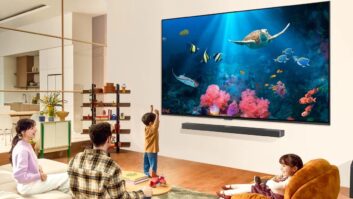Arlington, Va. – Despite the abundance of new OLED- and LCD-enabled
products flooding the market, consumers continue to use televisions most often
to watch video programming, according to a new
Consumer
Electronics Association (CEA
) study.
According to “The Evolving Video Landscape,” consumers are
watching more video than they have in the past, across a variety of platforms.
One-third of U.S. adults online (34 percent) said they watch more
video content today than they did a year ago, and viewing of television video
programming is up 28 percent, with consumers citing convenience and the
appeal/variety of programming as the top factors to doing so, the CEA said.
Viewing of content on portable devices has also increased, with
40 percent watching more on those devices today than a year ago.
Some 66 percent of consumers who are watching video content on
television are simultaneously using other CE devices, the study found.
This behavior is more prevalent among younger consumers, as 85
percent of 18- to 24-year-olds and 70 percent of 25- to 34-year-olds multitask
with another device while watching video on a television.
U.S. adults online report watching some type of video content an
average of 3.2 hours a day, five days per week.
While televisions continue to be the most commonly used device
for watching video, other devices are gaining in popularity.
HDTVs, used by 66 percent of online adults, are the most
prevalent devices used for video viewing.
Computers ranked second with 62 percent reporting using a laptop
to watch video and 55 percent using a desktop.
One-third (33 percent) of consumers are using their smartphones
to watch video content, and 17 percent are using their tablets, the CEA found.
“Consumers are watching more video than they have in years past
and they are seeking devices and technologies that deliver a quality video and
audio experience,” said Shawn DuBravac, CEA’s chief economist and research
director. “However, younger consumers accustomed to multitasking are defining
new video behaviors as they watch video content across multiple platforms, on
their own schedule, all while interacting socially on their devices with their
friends.”
Among consumers using televisions to watch video content, nearly
half (47 percent) also use their sets for other purposes. One in three (34
percent) consumers who use a television to watch video also use their set to
listen to music, and 21 percent use a television to listen to audio.
Usage also varies by age and the type of display owned. Consumers
younger than 25 rely on their TVs more for music, social media, going on the web
and communicating, the study found.
Consumers with Internet-enabled TVs use their displays in a
number of ways as well: 47 percent listen to music, 28 percent use social
media, 26 percent surf the web and 23 percent view photos.
Future television purchases will be based on better picture
quality and larger screen sizes as consumers will continue to seek the latest
innovations in the market.
Almost half (48 percent) of consumers planning to purchase a TV
in the next 12 months will be replacing an aging, obsolete or broken set.
However, 51 percent desire improved picture quality in a new
display, and half want a larger screen size.
Nearly one-quarter of consumers with intentions to purchase a TV
over the next year expect to purchase a 3DTV; 21 percent plan to purchase an
OLED display; and a quarter of consumers
plan to purchase an Internet-enabled TV.
“While stated purchase intentions do not always translate to
transactions, the study clearly shows many consumers have their eyes fixed on
newer TV technologies,” the CEA said.
“Easy access to the web makes TVs more versatile, allowing us to
stay connected, informed and entertained,” added DuBravac. “In the future, new
technologies, like OLED and 3D, will continue to improve the viewer experience,
and Internet-enabled sets will fulfill consumers’ desires to be connected.”
The “Evolving Video Landscape Study (April 2012)” was conducted
between Feb. 22 and March 2.
The complete study is available free to CEA member companies at
and may be purchased by non-members.













